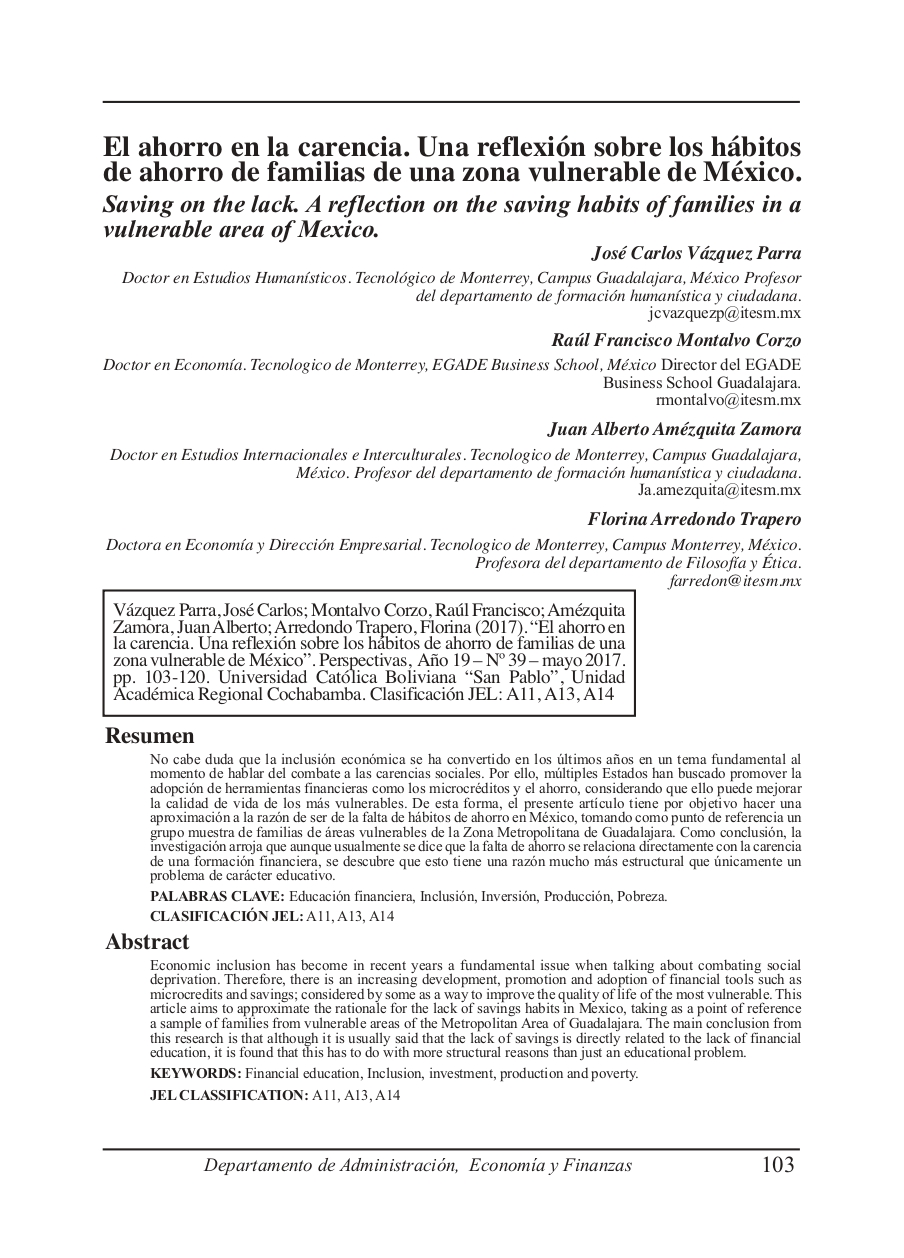Saving on the lack. A reflection on the saving habits of families in a vulnerable area of Mexico.
DOI:
https://doi.org/10.35319/6khdd557Keywords:
Financial education, Inclusion, investment, Production and povertyAbstract
Economic inclusion has become in recent years a fundamental issue when talking about combating social deprivation. Therefore, there is an increasing development, promotion and adoption of financial tools such as microcredits and savings; considered by some as a way to improve the quality of life of the most vulnerable. This article aims to approximate the rationale for the lack of savings habits in Mexico, taking as a point of reference a sample of families from vulnerable areas of the Metropolitan Area of Guadalajara. The main conclusion from this research is that although it is usually said that the lack of savings is directly related to the lack of financial education, it is found that this has to do with more structural reasons than just an educational problem.
Downloads
References
Añez, C., Urbina, A., & Ojeda, L. (2002). Factores determinantes del ahorro interno en América Latina. Revista de Ciencias Sociales, 8(2), 283-299.
Banco Mundial. (2009). Global monitoring report 2009: A development emergency.
BID. (2016). Más ahorro crítico para superar dificultades fiscales y estancamiento económico en América Latina y el Caribe. Washington D.C.: Banco Interamericano de Desarrollo.
Blankenhorn, D. (2008). Thrift: A Cyclopedia. Nueva York: Institute for American Values.
Bresser, L., & Gala, P. (2008). ¿Por qué el ahorro externo no promueve el crecimiento? Investigación Económica, LXVII(263), 107-130.
Castellano, M., Martínez, L., & De Pelekais, C. (2015). Negocios Inclusivos: Rentabilidad o filantropía empresarial. Forum Humanes, 4(1).
ENOE. (2014). Encuesta Nacional de Ocupación y Empleo.
FAO. (2003). Manual de Consulta sobre el Ahorro de Grupo. (ONU, Ed.) Recuperado en diciembre de 2016, de http://www.fao.org/3/a-y4094s.pdf
Fortaleza, A., Lucchetti, L., & Pallares, M. (2009). Measuring the Coverage Gap. En R. Holzman, D. Robalino, & N. Takayama (Eds.), Closing the Coverage Gap: Role of Social Pensions and other Retirement Income Transfers. Washington: Banco Mundial.
Fundación Capital & Instituto de Estudios Peruanos. (2012). Promoción de la cultura de ahorro en familias en pobreza.
Gaona, A. (2000). Desarrollo sostenible y desarrollo solidario. Comunicar, (15), 83-91.
Gutiérrez, R., & Lobo, I. (2006). ¿Es posible aliviar la pobreza a través de los negocios? Harvard Review of Latin America.
Isla, X., Martínez, F., & Rojo, J. (2000). Ahorro y sistema financiero. Revista Galega de Economía, 9(1), 0.
Licandro, O., & Pardo, L. (2013). Experiencias de Negocios Inclusivos en el Uruguay. Montevideo: Universidad Católica de Uruguay.
Montalvo, R., Vázquez, J. C., & Amézquita, J. A. (2017). Desigualdad, microcréditos y desarrollo sostenible: un estudio en la Zona Metropolitana de Guadalajara. Ciencia Ergo Sum.
ONU. (Agosto de 2015). Objetivos del Desarrollo Sostenible. Recuperado el 02 de octubre de 2015, de http://www.nu.org.bo/objetivos-de-desarrollo-sostenible-ods/
PNUD. (2016). Programa de las Naciones Unidas para el Desarrollo en América Latina y el Caribe.
PNUD México. (2015). Programa de las Naciones Unidas para el Desarrollo. México.
Prahalad, C. K., & Stuart, L. H. (2002). The fortune at the Bottom of the Pyramid. Strategy and Business, (26).
Rasccanello, K., & Herrera, E. (2014). Educación e Inclusión financiera. Revista Latinoamericana de Estudios Educativos, XLV(2), 119-141.
Reuters. (14 de junio de 2016). Crisis de ahorro en América Latina restringe su crecimiento económico. América Economía. Recuperado en diciembre de 2016, de http://www.americaeconomia.com/economia-mercados/finanzas/crisis-de-ahorro-en-america-latina-restringe-su-crecimiento-economico
Robinson, M. (2001). The Microfinance Revolution: Sustainable Finance for the Poor. Washington: The World Bank.
Tejerina, L. (2016). Banco Interamericano del Desarrollo.
UNICEF México. (2015). Trabajo Infantil en México.
Villagómez, A. (2014). El ahorro para el retiro. Una reflexión para México. El Trimestre Económico, 81(323), 549-576.

Published
Issue
Section
License
Copyright (c) 2017 Revista Perspectivas

This work is licensed under a Creative Commons Attribution-NonCommercial-ShareAlike 4.0 International License.
La Revista Perspectivas de la Universidad Católica Boliviana, es una revista de acceso abierto, por lo tanto, es de libre acceso en su integridad. Está permitida su lectura, búsqueda, descarga, distribución y reutilización legal en cualquier tipo de soporte únicamente para fines no comerciales, siempre y cuando la obra sea debidamente citada.




